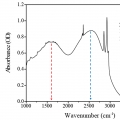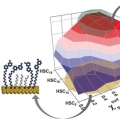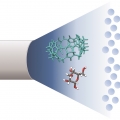| 첨부 '1' |
|---|
| author | Jong Seung Kim |
|---|---|
| journal | Acc. Chem. Res., 2015, 48 (11), pp 2935–2946 |
| Homepage | http://orgchem.korea.ac.kr/index2.asp |
Theranostics, chemical entities designed to combine therapeutic effects and imaging capability within one molecular system, have received considerable attention in recent years. Much of this interest reflects the promise inherent in personalized medicine, including disease-targeted treatments for cancer patients. One important approach to realizing this latter promise involves the development of so-called theranostic conjugates, multicomponent constructs that selectively target cancer cells and deliver cytotoxic agents while producing a readily detectable signal that can be monitored both in vitro and in vivo. This requires the synthesis of relatively complex systems comprising imaging reporters, masked chemotherapeutic drugs, cleavable linkers, and cancer targeting ligands. Ideally, the cleavage process should take place within or near cancer cells and be activated by cellular components that are associated with cancer states or specifically expressed at a higher level in cancer cells. Among the cleavable linkers currently being explored for the construction of such localizing conjugates, disulfide bonds are particularly attractive. This is because disulfide bonds are stable in most blood pools but are efficiently cleaved by cellular thiols, including glutathione (GSH) and thioredoxin (Trx), which are generally found at elevated levels in tumors. When disulfide bonds are linked to fluorophores, changes in emission intensity or shifts in the emission maxima are typically seen upon cleavage as the result of perturbations to internal charge transfer (ICT) processes. In well-designed systems, this allows for facile imaging. In this Account, we summarize our recent studies involving disulfide-based fluorescent drug delivery conjugates, including preliminary tests of their biological utility in vitro and in vivo.
To date, a variety of chemotherapeutic agents, such as doxorubicin, gemcitabine, and camptothecin, have been used to create disulfide-based conjugates, as have a number of fluorophores, including naphthalimide, coumarin, BODIPY, rhodol, and Cy7. The resulting theranostic core (drug−disulfide−fluorophore) can be further linked to any of several site-localizing entities, including galactose, folate, biotin, and the RGD (Arg-Gly-Asp) peptide sequence, to create systems with an intrinsic selectivity for cancer cells over normal cells. Site-specific cleavage by endogenous thiols serves to release the cytotoxic drug and produce an easy-to-monitor change in the fluorescence signature of the cell. On the basis of the results summarized in this Account, we propose that disulfide-based cancer-targeting theranostics may have a role to play in advancing drug discovery efforts, as well as improving our understanding of cellular uptake and drug release mechanisms.

http://pubs.acs.org/doi/abs/10.1021/acs.accounts.5b00406
-
Read More

Highly Efficient Fullerene-Free Polymer Solar Cells Fabricated with Polythiophene Derivative
A highly efficient fullerene-free polymer solar cell (PSC) based on PDCBT, a polythiophene derivative substituted with alkoxycarbonyl, has achieved an impressive power conversion efficiency of 10.16%, which is the best result in PSCs based o... -
Read More

Low-voltage organic devices based on pristine and self-assembled monolayer-treated HfTiOx gate dielectrics
Low-voltage organic field-effect transistors (OFETs) and complementary metal oxide semiconductor (CMOS) inverters based on pentacene and N,N′-ditridecylperylene-3,4,9,10-tetracarboxylic diimide (PTCDI-C13) were fabricated on HfTiOx gate diel... -
Read More

Higher Quantum State Transitions in Colloidal Quantum Dot with Heavy Electron Doping
Electron occupation in the lowest quantized state of the conduction band (1Se) in the colloidal quantum dot leads to the intraband transition in steady-state (1Se-1Pe). The intraband transition, solely originating from the quantum confinemen... -
Read More

High-harmonic generation: Drive round the twist
Light has long been used to detect the chirality of molecules but high-order harmonic generation now provides access to these chiral interactions on ultrafast timescales. http://www.nature.com/nphys/journal/v11/n8/full/nphys3395.html -
Read More

Gradients of Rectification: Tuning Molecular Electronic Devices by the Controlled Use of Different-Sized Diluents in Heterogeneous Self-Assembled Monolayers
Molecular electronics has received significant attention in the last decades. To hone performance of devices, eliminating structural defects in molecular components inside devices is usually needed. We herein demonstrate this problem can be ... -
Read More

Investigation of Charge Carrier Behavior in High Performance Ternary Blend Polymer Solar Cells
This study demonstrates high-performance, ternary-blend polymer solar cells by modifying a binary blend bulk heterojunction (PPDT2FBT:PC71BM) with the addition of a ternary component, PPDT2CNBT. PPDT2CNBT is designed to have complementary ab... -
Read More

Adsorption of Carbon Dioxide on Unsaturated Metal Sites in M2(dobpdc) Frameworks with Exceptional Structural Stability and Relation between Lewis Acidity and Adsorption Enthalpy
A series of metal–organic frameworks (MOFs) M2(dobpdc) (M=Mn, Co, Ni, Zn; H4dobpdc=4,4′-dihydroxy-1,1′-biphenyl-3,3′-dicarboxylic acid), with a highly dense arrangement of open metal sites along hexagonal channels were prepared by microwave-... -
Read More

Programmed activation of cancer cell apoptosis: A tumor-targeted phototherapeutic topoisomerase I inhibitor
We report here a tumor-targeting masked phototherapeutic agent 1 (PT-1). This system contains SN-38—a prodrug of the topoisomerase I inhibitor irinotecan. Topoisomerase I is a vital enzyme that controls DNA topology during replication, trans... -
Read More

Probing Distinct Fullerene Formation Processes from Carbon Precursors of Different Sizes and Structures
Fullerenes, cage-structured carbon allotropes, have been the subject of extensive research as new materials for diverse purposes. Yet, their formation process is still not clearly understood at the molecular level. In this study, we performe... -
Read More

Manifesting Subtle Differences of Neutral Hydrophilic Guest Isomers in a Molecular Container by Phase Transfer
Achieving strong host–guest interactions between synthetic hosts and hydrophilic guests in solution is challenging because solvation effects overwhelm other effects. To resolve this issue, we transferred complexes of cucurbit[7]uril (CB[7]) ... -
Read More

Structure and assembly mechanisms of toxic human islet amyloid polypeptide oligomers associated with copper
Amyloidosis is a clinical disorder implicated with the formation of toxic amyloid aggregates. Despite their pathological significance, it is challenging to define the structural characteristics of amyloid oligomers owing to their metastable ... -
Read More

A High Efficiency Nonfullerene Organic Solar Cell with Optimized Crystalline Organizations
A well-organized donor–acceptor crystalline structure is examined for high performance nonfullerene solar cells. By thermal annealing, nanoscale structures of both donor and acceptor domains are successfully modulated, followed by signific... -
Read More

Diastereomeric Resolution of a Racemic Biaryl Boronic Acid and Its Application to Divergent Asymmetric Total Syntheses of Some Axially Chiral Natural Products
The asymmetric total syntheses of deshydroxy-tetramethylcupressuflavone and desmethylkotanin and the synthesis of a key intermediate in the previous synthesis of hibarimicinone were described using an axially chiral biaryl boronic acid, prep... -
Read More

Origin of the Reversible Thermochromic Properties of Polydiacetylenes Revealed by Ultrafast Spectroscopy
Polydiacetylenes (PDAs) with thermochromic properties undergo colorimetric transitions when the external temperature is varied. This capability has the potential to enable these materials to be used as temperature sensors. These thermochromi... -
Read More

Facet-controlled hollow Rh2S3 hexagonal nanoprisms as highly active and structurally robust catalysts toward hydrogen evolution reaction
Hollow Rh2S3 hexagonal nanoprisms, prepared by one-step formation of Cu1.94S@Rh2S3core-shell nanoprisms followed by the etching of core, exhibit very high catalytic activity and excellent stability toward hydrogen evolution reaction under ha... -
Read More

High Aspect Ratio Conjugated Polymer Nanowires for High Performance Field-Effect Transistors and Phototransistors
We synthesized a highly crystalline DPP-based polymer, DPPBTSPE, which contained 1,2-bis(5-(thiophen-2-yl)selenophen-2-yl)ethene as a planar and rigid electron donating group. High- and low-molecular weight (MW) DPPBTSPE fractions were colle... -
Read More

Supramolecular Enhancement of Protein Analysis via the Recognition of Phenylalanine with Cucurbit[7]uril
Mass spectrometry (MS)-based analysis using enzymatic digestion is widely used for protein sequencing and characterization. The large number of peptides generated from proteolysis, however, suppresses the signal of peptides with low ionizati... -
Read More

Disulfide-Based Multifunctional Conjugates for Targeted Theranostic Drug Delivery
Theranostics, chemical entities designed to combine therapeutic effects and imaging capability within one molecular system, have received considerable attention in recent years. Much of this interest reflects the promise inherent in personal... -
Read More

Spectroscopically tracking charge separation in polymer : fullerene blends with a three-phase morphology
The coexistence of intermixed amorphous polymer : fullerene phases alongside pure semicrystalline polymer and fullerene phases provides a plausible explanation for effective charge separation in organic photovoltaic blends by providing a cas... -
Read More

Chromogenic/Fluorogenic Ensemble Chemosensing Systems
Nature has endowed human beings with many useful functions, by virtue of supramolecular chemistry. As is well-known, nature can self-assemble relatively small molecular precursors into very complicated biomolecules. These supramolecular ense...


 Supramolecular Enhancement of Protein Analysis via the Recogn...
Supramolecular Enhancement of Protein Analysis via the Recogn...
 Spectroscopically tracking charge separation in polymer : ful...
Spectroscopically tracking charge separation in polymer : ful...